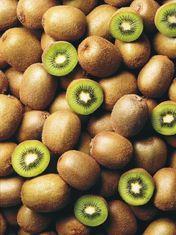
French kiwifruit fared much better last season as good growing conditions contributed to the recovery volume.
The French crop was 76,000 tonnes, the equivalent of 15 per cent of the total EU harvest, and around eight per cent of global production.
The French market also received a boost in terms of exports up to 29,500t, from 27,400t in the previous year. The season was helped by some degree to an earlier finish to the New Zealand campaign.
Further growth is forecast as new plantings reach full cropping status. The last two years have seen a 10 per cent rise in plantings to 4,250 hectares.
France has also received additional impetus from a new focus on Zespri Gold™, which is currently being grown under contract, and the development of non-traditional outlets, notably Taiwan and Hong Kong.
Meanwhile, Italy a key player in kiwifruit, responsible for 38 per cent of global production - excluding China, suffered to some degree in the 2002/03 season.
The Italian crop was adversely affected by cold weather and frosts, which saw big losses, particularly of Zespri Gold™, also grown under contract.
Due to the difficult weather conditions there was a drop in production, which fell short of the initial estimate of 390,000t. The drop was in spite of rises in the planted area in Piemonte and Lazio, which together hold a 50 per cent share of the total.
Italian exports rose to 295,000t, though, up from 250,000t on the previous year. Most of the fruit went to the EU, with markets in Germany, Spain, the Netherlands, France and the UK. Gains were made elsewhere, especially in Poland and key Asian markets. In the long term, exporters are looking to establish a following in Japan and Korea.
Greece had a difficult time due to tough weather conditions causing problems. Snow and savage frosts, especially in the north contributed to a 38 per cent reduction in the country’s harvest last season. Overall, it amounted to 25,000t, compared with 40,000t and 73,600t for the two previous seasons.
This fall in production meant there was a 26 per cent slump in exports to 16,250t, against 22,000t and 33,254t in the previous seasons. However, even before the difficult weather conditions the industry was having problems. Domestic sales were being squeezed by strong competition, while depressed prices were having a negative effect on exports.
Inclement weather also hindered Spanish kiwifruit production. This impacted on exports, which saw a marginal slip from 11,660t to 11,500t. Around 60 per cent of this went to Portugal, seven per cent to France and six per cent to Italy. The UK ranked eighth after Germany, Morocco and Poland.
There is little expansion planned ahead in Spain. This is largely due to the high cost of land, particularly in Galicia in the north west, and limited area in other major producing regions.
The Portuguese market was improved by better weather, which saw the kiwifruit harvest rise to 7,500t. This represented a 65 per cent increase on the 4,500t of the previous season, when crops were knocked by spring frosts, poor pollination and heavy rains.
Exports also rose to 800t, the highest level since the late 1990s. Around 70 per cent went to the Netherlands, with the remainder channelled to Spain, Brazil, Canada and Cape Verde. Despite the increased volumes, growers and exporters still faced difficulties, with competition from other European nations and also Chile, a scenario exacerbated by low prices and disappointing returns.
In the southern hemisphere the Chilean harvest saw a reduction of around 10-15 per cent due to difficult weather. The fall in production hit exports, which fell eight per cent to 113,856t, compared with 124,106t the season before, a situation further compounded by strong competition from New Zealand.
Although sendings to the US dropped 17 per cent and those to Latin America by 45 per cent, the Middle and Far East witnessed growth of 16 per cent and nine per cent respectively. The position was bolstered further by buoyant prices on the international market.
The kiwifruit sector is one of the most important within New Zealand horticulture, and continues to face competition particularly from Chile and Italy.
Frosts, in the Bay of Plenty, Hawkes Bay and Gisborne severely impacted production. The outcome was a 10 per cent fall in output, of which 78 per cent was sourced from the Bay of Plenty.
The drop in production also affected revenue, which dropped to NZ $566.9m. But there were still some gains. Spain, Germany, Portugal and North America strengthened their profile as importers of traditional green varieties. Taiwan and Korea grew in stature for gold and there was a marked rise in organic sales.
Further growth is forecasted and backed by new plantings, strategies to enhance flavour and investment in modern pre and post-harvest facilities. There have also been moves to set up an industry advisory council to improve marketing at all levels of the supply chain.



